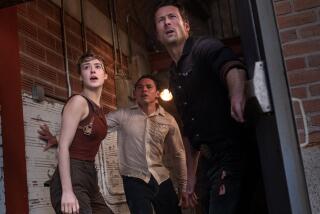MOVIE REVIEW : Beauty, Horror Emerge From IMAX’s ‘Fires of Kuwait’
Good documentaries reveal the physical world and its workings. Great or exceptional documentaries show them in ways we’ve never seen or imagined before.
*
In “Fires of Kuwait” (IMAX Theater), easily the most spectacular and exciting of all the IMAX documentaries, the filmmakers give us something we really have never seen before, never will again. They show us a cataclysm, vast and hideous, that beggars most nightmares, reduces most other catastrophes to small change. And a battle against it, equally vast, strange and marvelous.
The landscape of death and destruction stretching out in the movie’s spine-tingling opening--revealed to us in all of IMAX’s gigantic spread and depth of focus--is truly wild and weird: a dark desert with 200 oil-well fires raging out of control, set by the retreating Iraqi armies after Operation Desert Storm.
Some of the images in David Douglas’ astonishing documentary--the wilderness covered by gigantic clouds of smoke that blot out all trace of the sun, illumined by huge geysers of fire erupting hundreds of feet into the air--create a vision both awesome and infernal, a view of what can truly be described as hell on Earth.
Hell, happily air-conditioned, if only for moviegoers. On IMAX’s six-story-high screen, we see Kuwait’s fires, especially the Burgan field fires, just as the firefighters did. But we don’t feel the temperatures of nearly 2,000 degrees Fahrenheit that left firefighters nearest the blazes sweating a quart of water every hour.
As in all the best IMAX films, this one turns the camera into a giant eye. Douglas, a longtime expert cinematographer (“The Rolling Stones at the Max”), surpasses himself here in all three of his roles: directing, shooting and scripting. He and his tiny five-person crew catch the fires at their hottest, the ordeal at its most dangerous.
Indeed, these 200 fires, all but 15 of which were put out during the month of the film’s shoot in October, 1991, represent about a third of the 607 wells torched by the retreating armies. So, what we’re witnessing here is the month hell was made manageable.
It’s elsewhere that you’ll have to look for any historical analysis of the Kuwait invasion and Desert Storm. Here, we get it in only the tersest way: a shot of maps, a shot of Saddam Hussein firing off a gun, of George Bush saying, with patrician stiffness, “This will not stand.”
But politics aren’t at the core of the film, even the devious geopolitics of Kuwait. Nor perhaps should they be. In many ways, “Kuwait” is an old-fashioned heroic American action movie. And the heroes it celebrates most vividly--because they’re the ones who invited IMAX along--are the salty Texans of Wild Well Control Corp., a Houston-based firefighting outfit, who mix their expertise with banal banter and baseball games.
Wild Well was one of a number of teams from 10 different countries, including both the United States and the old Soviet Union, working on the fires. As we see them here, the methods of all were various. Salt water piped from the sea and shot into the endless furnace. A “Big Wind” manufactured by old MIG fighters with water in their jet streams. Something called a Venturi Tube, which is lowered, straw-like, right over the fiery geyser. And a quintessential Texas method: using dynamite to knock the fire flat, killing the blaze in the fleeting moments the blast sucks all oxygen away from it.
Hellish , wonderful . . . These words fit the nerve-rending visions of “Fires of Kuwait.” But, in the hands of the IMAX crew, the horrific images become magical. And beautiful: the beauty of chaos, the wonder of human cooperation.
The 36 minutes of “Fires of Kuwait” (Times-rated: Family) generate, perhaps more than any other movie this year, the mesmerizing spectacle of something unique and unrepeatable: a landscape of omnipresent death, succumbing finally to the human wit and will set against it. That may not be consoling, but it is unforgettable.
‘Fires of Kuwait’
A Black Sun Films Ltd. production, released by IMAX Corp. Director/Cinematographer/Screenplay David Douglas. Producer Sally Dundas. Co-producer Di Roberts. Executive producer Andre Picard. Editor Barbara Kerr. Music Michael Brook. Supervising Sound Editor Peter Thillaye. Narrator: Rip Torn. Running time: 36 minutes.
Times-rated: Family.
More to Read
Only good movies
Get the Indie Focus newsletter, Mark Olsen's weekly guide to the world of cinema.
You may occasionally receive promotional content from the Los Angeles Times.










